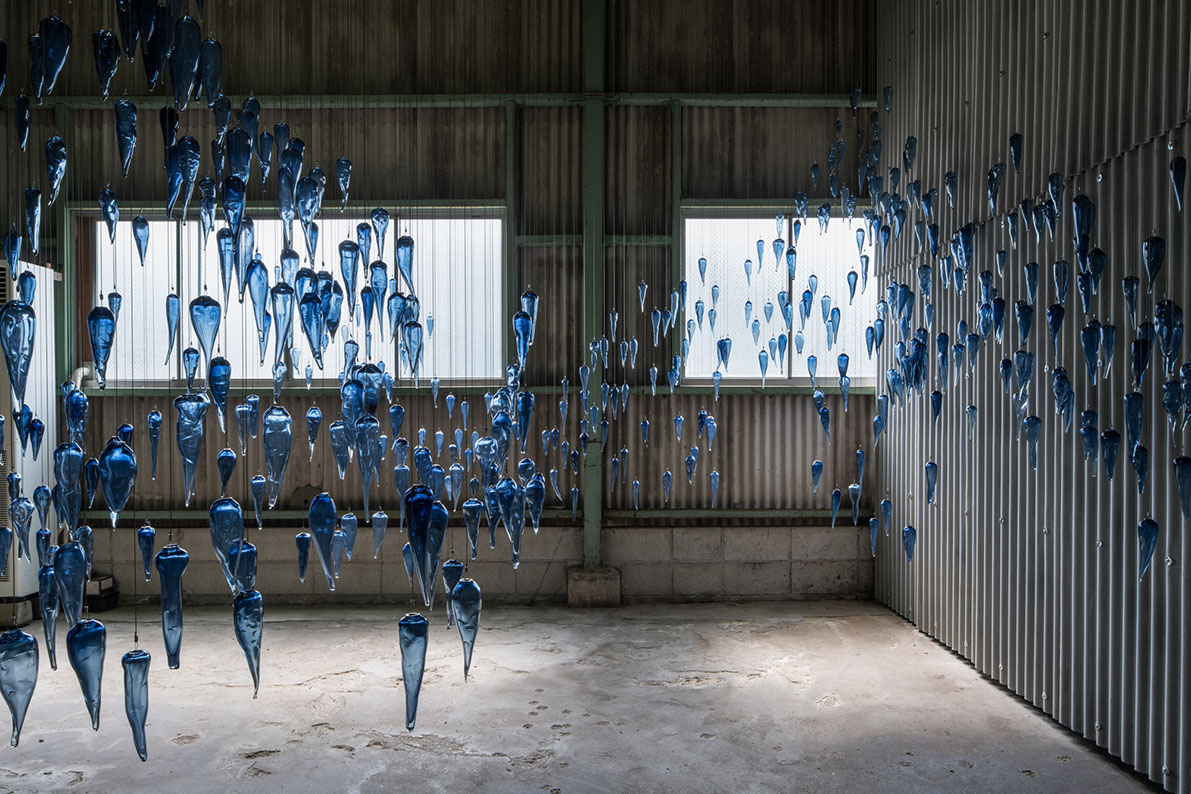ARTISTS
Yhonnie Scarce
- Born 1973 in Woomera, Australia.
- Based in Melbourne, Australia.
AR07
The Arimatsu and Narumi shibori textile workshop Harisho, established in 1897, has carried on traditions such as sekka (snowflake) shibori using Chita cotton, and after World War II revived the traditional technique of mame [bean] shibori. Here Scarceʼs Orford ness (2022) occupies half of the space. Visitors can walk through approximately 1,000 pieces of suspended glass that evoke clouds and rain, and can also see historical materials relating to Harisho, which exported large amounts of colorfully dyed shibori textiles to Congo, Africa in the immediate postwar period. Meanwhile, the roots of Scarceʼs practice can be traced to the Cold War.
Scarce was born in Woomera, with maternal grandparents of the Aboriginal Australian Kokatha and Nukunu people. Between 1952 and 1957, during the administration of Prime Minister Robert Menzies, twelve large-scale nuclear tests were conducted by the British in South Australia and Western Australia, and seven of these were conducted at Maralinga, 600 km west of Woomera.* Scarceʼs practice is motivated by the responsibility to remember and retell ancestral stories, and by the history and shared memory of a land scarred by human wrongs such as war and colonialism. The glass pieces are shaped like yams, a staple food of the Aboriginal people of Australia and an important cultural and spiritual symbol.
Her works convey to humankind, which consistently fails to learn from history, a memento mori (reminder of death), urging remembrance of casualties of nuclear testing, forced displacement of residents, and contamination of the environment. Given the current circumstances, one may also be reminded of art history, in that memento mori became a favored European painting subject after the Black Plague subsided in the 14th century.
Scarce has had solo and group exhibitions at the IAIA Museum of Contemporary Native Arts (Santa Fe, USA, 2022), concurrently at the Australian Centre for Contemporary Arts (Melbourne) and Institute of Modern Art (Brisbane) (2021), and at the TarraWarra Museum of Art in Victoria, Australia.
* Una Ray, “The Myth of Empty Country And the Story of ʻDeadlyʼ Glass,” diʼvan / A Journal of Accounts, Divan Art Journal and University of NSW Art & Design, Sydney, March 2021 (issue 9), pp. 42–52.
- Selected Works & Awards
-
- 2022
- Reclaim the Earth, Palais de Tokyo, Paris, France
- 2022
- Exposure: Native Art and Political Ecology, IAIA Museum of Contemporary Native Arts, Santa Fe, USA
- 2021
- Yhonnie Scarce: Missile Park, Australian Centre for Contemporary Art, Melbourne/Institute of Modern Art, Brisbane, Australia
- 2020
- Looking Glass: Judy Watson and Yhonnie Scarce, Tarrawarra Museum of Art, Melbourne, Australia/Flinders University Museum of Art, Adelaide, Australia
- 2020
- Small Building Award, Dezeen Awards
- 2019
- National Gallery of Victoria Architecture Commission, National Gallery of Victoria, Melbourne, Australia
- 2018
- Winner, Kate Challis RAKA Award, Australia
Exhibition
Orford ness, 2022
AR07

- Installation view at Aichi Triennale 2022
- Orford ness, 2022
- Photo: ToLoLo studio
- Open
- 10:00-17:00
*Last admission 15 min before closing time
- Closed
- Wednesdays
- Venue / Access
- THE HARISHO CO., Ltd.
- 4 minutes on foot from Arimatsu Station on the Meitetsu Nagoya Line.


![STILL ALIVE Aichi Triennale 2022, July 30 (Saturday) to October 10 (Monday, public holiday), 2022 [73 days]](/2022/en/img/title-logo-date-en.svg)
